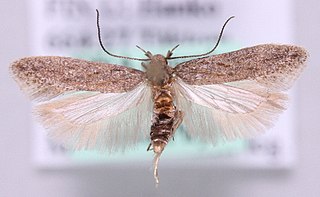Purslane is a common name for several mostly unrelated plants with edible leaves and may refer to:

Halimione portulacoides, commonly known as sea purslane, is a shrub found in Eurasia.
Sea purslane is a common name for several plants and may refer to:

Coleophora versurella is a moth of the family Coleophoridae. It was described by Philipp Christoph Zeller in 1849.

The Sečovlje Saltworks is the largest Slovenian salt evaporation pond. Along with the Strunjan Saltworks, they are the northernmost Mediterranean saltworks and one of the few where salt is still produced in a traditional way, as well as a wetland of international importance and a breeding place for waterbirds. They are part of the Piran Saltworks and are located at Parecag in Slovenian Istria, the southwest of the country, at the Adriatic Sea, along the mouth of the Dragonja River near Sečovlje.

Coleophora atriplicis is a moth of the family Coleophoridae found in Europe and North America.
Coleophora afrosarda is a moth of the family Coleophoridae that can be found in such European countries as Portugal, France, Greece, Spain, and island of Sardinia. It can also be found in Tunisia of North Africa.
Coleophora guadicensis is a moth of the family Coleophoridae. It is found in Spain.

Halimione is a plant genus from the subfamily Chenopodioideae of the family Amaranthaceae. It is a sister genus of Atriplex and is included in that genus by Plants of the World Online.

Scrobipalpa atriplicella, the goosefoot groundling moth, is a moth of the family Gelechiidae. It is found from most of Europe throughout Asia to Kamchatka and Japan. It is an introduced species in North America.

Scrobipalpa nitentella, the common sea groundling, is a moth of the family Gelechiidae. It is found in most of Europe, North Africa (Tunisia), Turkey, Afghanistan, Kazakhstan, China, Mongolia and Siberia (Transbaikalia).
Scrobipalpa halimioniella is a moth in the family Gelechiidae. It was described by Peter Huemer and Ole Karsholt in 2010. It is found southern France and has also been recorded from Ukraine.
Juncus rigidus is a species of rush known by the common name sea rush. It is native to much of Africa and parts of western Asia. It is found inland and by the sea in sandy saline habitats.
Microbacterium agarici is a Gram-positive and rod-shaped bacterium from the genus Microbacterium which has been isolated from the mushroom Agaricus blazei in Taiwan.
Microbacterium endophyticum is a bacterium from the genus Microbacterium which has been isolated from the plant Halimione portulacoides from the Ria de Aveiro in Portugal.
Microbacterium halimionae is a bacterium from the genus Microbacterium which has been isolated from the salt-marsh plant Halimione portulacoides near the Ria de Aveiro in Murtosa, Portugal.
Microbacterium yannicii is a Gram-positive, rod-shaped, microaerophilic and non-motile bacterium from the genus Microbacterium which has been isolated from roots of the plant Arabidopsis thaliana in Golm, Germany.
Altericroceibacterium endophyticum is a Gram-negative, rod-shaped and motile bacterium from the genus Altericroceibacterium which has been isolated from the plant Halimione portulacoides.
Alteriqipengyuania halimionae is a Gram-negative, rod-shaped and motile bacterium from the genus Alteriqipengyuania which has been isolated from the plant Halimione portulacoides.
Zunongwangia endophytica is a Gram-negative and rod-shaped bacterium from the genus of Zunongwangia which has been isolated from the plant Halimione portulacoides from Ria de Aveiro in Portugal.






